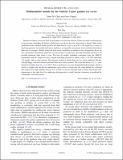Multimediator models for the Galactic Center gamma ray excess
Author(s)
Cline, James M.; Dupuis, Grace; Liu, Zuowei; Xue, Wei
DownloadPhysRevD.91.115010.pdf (3.272Mb)
PUBLISHER_POLICY
Publisher Policy
Article is made available in accordance with the publisher's policy and may be subject to US copyright law. Please refer to the publisher's site for terms of use.
Terms of use
Metadata
Show full item recordAbstract
Tentative evidence for excess GeV-scale gamma rays from the Galactic Center has been corroborated by several groups, including the Fermi collaboration, on whose data the observation is based. Dark matter annihilation into standard model particles has been shown to give a good fit to the signal for a variety of final state particles, but models with heavy mediators are typically inconsistent with constraints from direct detection or monojets. Models where the dark matter annihilates to mediators that subsequently decay are less constrained. We perform global fits of such models to recent data, allowing branching fractions to all possible fermionic final states to vary. The best fit models, including constraints from the AMS-02 experiment (and also antiproton ratio), require branching primarily to muons, with a ~10–20% admixture of b quarks, and no other species. This suggests models in which there are two scalar mediators that mix with the Higgs, and have masses consistent with such a decay pattern. The scalar that decays to μ[superscript +]μ[superscript -] must therefore be lighter than 2m[subscript τ] ≅ 3.6 GeV. Such a small mass can cause Sommerfeld enhancement, which is useful to explain why the best-fit annihilation cross section is larger than the value needed for a thermal relic density. For light mediator masses (0.2–2) GeV, it can also naturally lead to elastic dark matter self-interactions at the right level for addressing discrepancies in small structure formation as predicted by collisionless cold dark matter.
Date issued
2015-06Department
Massachusetts Institute of Technology. Center for Theoretical Physics; Massachusetts Institute of Technology. Department of PhysicsJournal
Physical Review D
Publisher
American Physical Society
Citation
Cline, James M., Grace Dupuis, Zuowei Liu, and Wei Xue. “Multimediator Models for the Galactic Center Gamma Ray Excess.” Phys. Rev. D 91, no. 11 (June 2015). © 2015 American Physical Society
Version: Final published version
ISSN
1550-7998
1550-2368